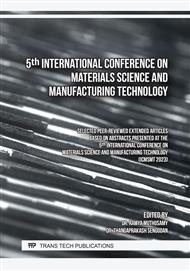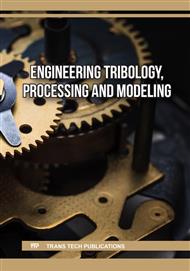p.33
p.41
p.47
p.55
p.63
p.71
p.79
p.93
p.107
Physical Experiments and DEM Simulations for Erosion of Iron Target by Two Impingements of Al2O3 Particle with Impingement Angles of Double 90º
Abstract:
In mechanical equipment interacting with impingement particles, worn surface morphology of parts and components is formed by an accumulative action of a large number of single-particle erosions. To exhibit the mechanism of multi-particle erosion of target, three physical experiments and Discrete Element Method (DEM) simulations of erosion of iron target by the two vertical impingements of Al2O3 particle are carried out under three different landing errors x of the two impingements. The experimental results showed that each of two overlapping worn morphologies by the two impingements has an spherical cap shape. When x is larger than radius R1 of worn morphology of target by the first erosion, two morphologies with an spherical cap shape are very close in size; while the size of worn morphology by the second erosion increases with the decrease of x, when x is smaller than R1. The predicting worn morphologies by DEM are almost consistent with the experimental results, where the maximum relative deviation in size of worn morphology is 2.98% in the direction along x, and is 3.93% in the direction perpendicular to x. All these proved the effectiveness of the DEM model in predicting erosion of target by two impingements of particle.
Info:
Periodical:
Pages:
63-68
Citation:
Online since:
January 2024
Authors:
Price:
Сopyright:
© 2024 Trans Tech Publications Ltd. All Rights Reserved
Share:
Citation:



